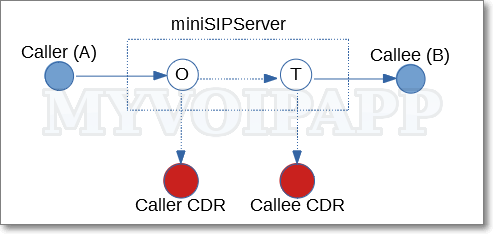To understand CDR details of miniSIPServer, we need to understand basic call model of miniSIPServer firstly. It is a half-call model defined in standard ETSI-23.078. Simply, it seperates one call to two half calls: (1) originating half; and (2) terminating half. Please refer to the figure below.

In the basic call, such as A calls B in above figure, miniSIPServer assigns two call sessions (half calls) to connect to each side. One session is used to connect caller user who orginate the call, we name it to be "caller side" or "O-side". Another session is used to connect the target user, we name it to be "callee side" or "T-side".
Each session can generate its own CDR. That means there could have two CDR records for one call. The CDR from O-side is "caller CDR" or O-CDR, and CDR from T-side is "callee CDR" or T-CDR. That's the CDR model of miniSIPServer. Please refer to the figure below.

Local miniSIPServer can be configured to generate different O-CDR and T-CDR records in different scenarios, but cloud miniSIPServer (1) can only generate O-CDR records, and (2) always generate a CDR for each call no matter it is answered or not.
All CDR records are saved in cloud databases. Records will be kept for 7 days, then all of them will be deleted completely from the cloud system.
In the main window, please click menu "CDR" to get two kinds of CDR tables.

- Basic call - This table displays all calls whose target users have answered the calls.
- Failed call - This table displays all calls whose target users didn't answer the calls, so these calls can be unreachable calls, busy calls, and so on.
Please refer to the table below for the details on each item in CDR records.
| Item | Description |
|---|---|
| Caller number | The number of caller who originates the call. |
| Dialed number | The original called number of the call. It is the number that the caller party dials to originate the call. |
| Destination number | The final called number of the call. In most scenario, this number is same as 'dialed_number', but they could be different in some scenarios. For examples, in auto-attendant service, the caller party can dial a number to trigger auto-attendant service, and input the destination number in the IVR procedure. |
| Duration (seconds) | This is the duration that both sides talk to each other. |
| Setup time | The timestamp when miniSIPServce receives the call. |
| Connect time | The timestamp when the callee side answers the call. |
| Release time | The timestamp when the call is disconnected. |